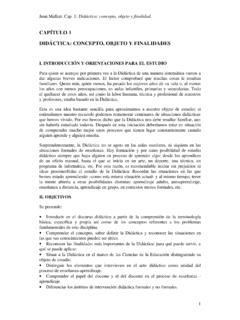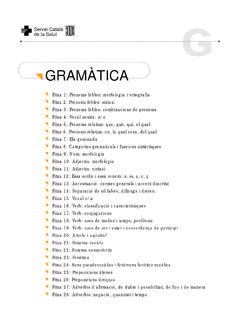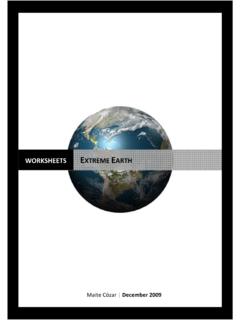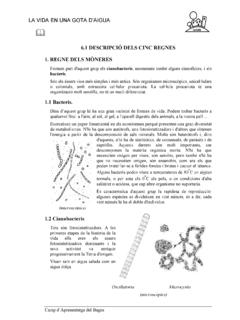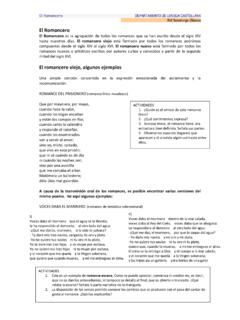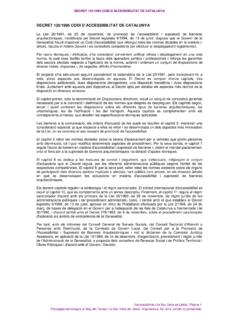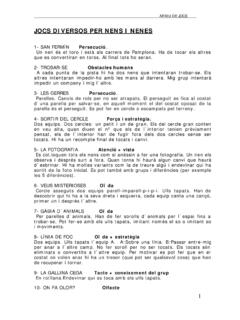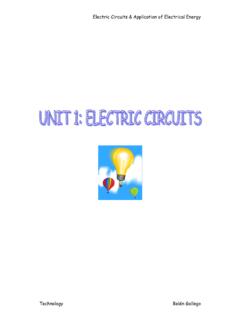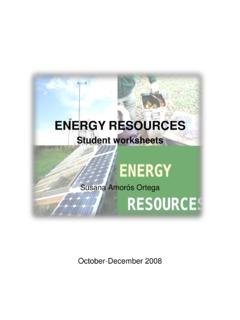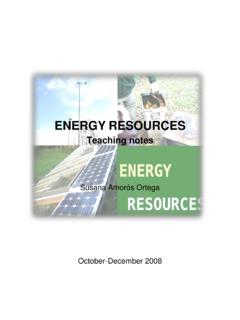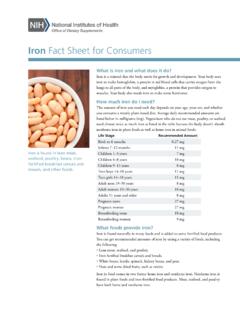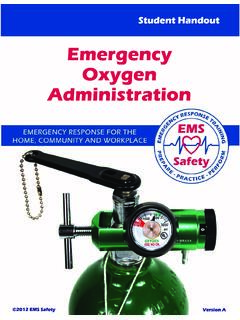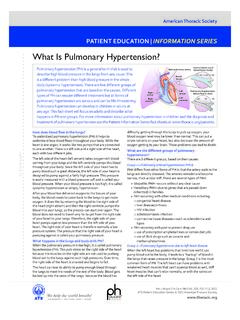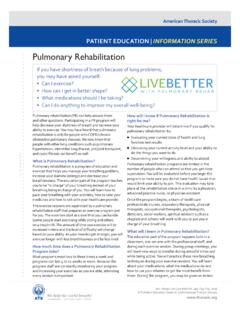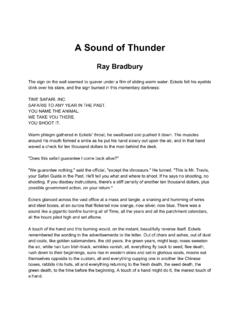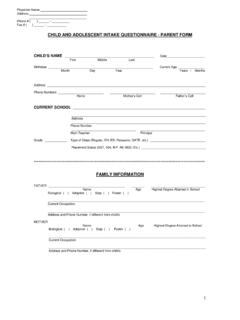Transcription of STUDENTS’ WORKSHEETS
1 Francesc Niella 2008. CEIP MONTSERRATINA - Viladecans students ' WORKSHEETS . HUMAN BODY. Joints, bones and muscles Systems of the body: respiratory, digestive and nervous A healthy body: food types,sport,taking care of your body NAME:_____. AGE-GROUP:_____. DATE:_____. 1. Francesc Niella 2008. CEIP MONTSERRATINA - Viladecans Joints are the places where two bones join together There are three types of joints : fixed (skull) gliding (vertebrae) movable (knee,elbow, ). Joints allow movement Ligaments connect bones in a joint MOVEMENT. In the picture we can see a pair of antagonist muscles , when one is contracted, the other one is relaxed. That is possible thanks to the elbow, a movable joint. 2. Francesc Niella 2008. CEIP MONTSERRATINA - Viladecans ACTIVITY 1: Complete the graph with the names of joints Any questions?
2 Hands up!! ACTIVITY 2: Write 5 correct sentences using the table below The knee They have a The skull Fixed limited range of The elbow Is movement The neck Movable BECAUSE. The shoulder Are It/they can move The vertebrae freely The wrists Gliding It can't move 3. Francesc Niella 2008. CEIP MONTSERRATINA - Viladecans ACTIVITY 3: Ask and answer questions with your partner about joints a) Where is / are the ..? b) What type of joint is this? c) Can you move it? d) What muscles are involved? e) Think of 3 other joints in your mother tongue and look them up in a dictionary, share these with your partner If you need them, use these structures: a) Here is the I'm touching my This joint is . b) It is fixed I can move it so I'm not sure/ I don't know c) Yes / No / only a bit 4.
3 Francesc Niella 2008. CEIP MONTSERRATINA - Viladecans We all have skeletons inside our body: that makes us vertebrates. The skeleton has 3 main functions: It protects important parts of the body: the skull protects your brain It lets you move It Supports you body and keeps itupright by holding the different body parts in place Don't worry, that's not mine!! Skull Shoulder blade Humerus backbone Ribs pelvis Radius Ulna Femur Tibia 5. Francesc Niella 2008. CEIP MONTSERRATINA - Viladecans More about bones: - The body has a total of 206 bones, 29 of them in the head - The smallest bone is in your ear and the ! the femur - Some people have 11 or 13 pairs of ribs instead of 12. - Bone or joints can be substituded with artificial ones: protheses - Bones change with age, when you're a baby they bend rather than snap, later they become stiff so they crack rather than bend.
4 ACTIVITY 1: Complete the chart of the skeleton with the following bones: Skull, shoulder blade, ribs, humerus, radius, pelvis, femur, tibia and backbone 6. Francesc Niella 2008. CEIP MONTSERRATINA - Viladecans ACTIVITY 2: Fill in the gaps. Version A. The skeleton has 3 _____ . The _____ protects the brain and it also helps you stand _____ . The _____ bone in the body is the femur and we have 206 _____ in our _____. Upright - functions - bodies skull - longest - bones Version B. We have 12 pairs of _____ . They protect the _____ and lungs. The _____ bone is in our ear. Baby's _____ are _____( 2 words ) than adult's. The _____ is longer than the _____. ACTIVITY 3: Review and locate with a partner the names of bones studied Make comparisons between them Ask and answer questions Use these structures: The skull protects.
5 Which bone is it ? ( ) , point to Where's the ..? The radius is shorter The femur is longer Some students will answer questions about bones in front of the group .. so keep reviewing!! 7. Francesc Niella 2008. CEIP MONTSERRATINA - Viladecans Every action you do is carried out by a muscle. We have about 640 in the body As we have seen with joints they change in lenght, when contracted they get shorter and thicker, and when relaxed they get longer . The muscular system: It enables us to move ( as the skeleton). It gives the body shape It protects some important organs such as the liver trapezius Face muscles triceps chest shoulder biceps abdominals back quadriceps gluteus Femoral biceps calves 8. Francesc Niella 2008. CEIP MONTSERRATINA - Viladecans More about muscles : - The biggest muscle is not the biceps is the gluteus maximus, and you know where to find , there!
6 ! - muscles don't push, they can only pull or contract - muscles make up about two-fifths of the body's total weight - Larger and stronger muscles are a result of regular exercise and physical activities. ACTIVITY 1: Complete this mind map about muscles , bones, joints or other . Bones Other The Human Body muscles Joints Humerus - Liver Triceps calves elbow pelvis brain- chest knee abdominals wrist 9. Francesc Niella 2008. CEIP MONTSERRATINA - Viladecans ACTIVITY 2: Locate the following muscles and say if they are on the: ARM LEG UPPER BODY. Calves : _____ Shoulders: _____. Chest : _____ Quadriceps: _____. Triceps: _____ Abdominals: _____. ACTIVITY 3: Follow activity 2 orally with your partner Use these structures The biceps is in the .. Can you touch Flex your.
7 Point to Here, I have When I play tennis, I use .. ACTIVITY 4: Revision Lessons 1-2-3. Read the sentences carefully and write true (T) or false (F). We have 206 muscles in our bodies We can find the calves on the upper body The brain is an organ, not a muscle The elbow is a gliding joint The skeleton supports your body Our muscles make-up 10% of our body weight 10. Francesc Niella 2008. CEIP MONTSERRATINA - Viladecans The RESPIRATORY SYSTEM is made up of these main parts: Nasal cavity oral cavity trachea lungs and diaphragm Nasal cavity Oral cavity Trachea Tongue Right lung Left lung Diaphragm Breathing is with the heartbeat, the body's most essencial activity We breathe with our lungs. When we breathe in, we take oxygen from the air and we breathe out oxygen and carbon dioxide.
8 oxygen Carbon dioxide oxygen 11. Francesc Niella 2008. CEIP MONTSERRATINA - Viladecans Facts about breathing: - Even when you sleep, you breathe every 4 seconds - After much exercise, you breathe as fast as once each second - Yawning happens when the body has been still for a while, so more oxygen is needed - There's always around half litre of air in your lungs ACTIVITY 1: Complete the text with the words given: When breathing _____ , we take oxygen from the _____ . This oxygen goes to our _____ and distributed around the body. Then we breathe _____ and we expirate _____ . Out lungs carbon dioxide air in ACTIVITY 2 : Label the picture with the different parts of the respiratoty system 12. Francesc Niella 2008. CEIP MONTSERRATINA - Viladecans ACTIVITY 3: Divide into 3 groups of 3-5 students The teacher is going to assign an area of discussion, try to speak with your partners for 2-3 minutes.
9 Not another Areas for discussion: boring science Smoking and the respiratory system lesson!!! Exercise and breathing Asking and answering questions to your partners Use these structures: When you smoke, you breath in . Smoking is .. for your lungs When you exercise, you breathing goes .. Your lungs breath faster when . Why is breathing essencial? How many times do you breath in a minute? And in an hour? In a full day? When do you yawn? When I'm . Is breathing involuntary? 13. Francesc Niella 2008. CEIP MONTSERRATINA - Viladecans The body needs food and drink Food contains many substances that help the body grow and repair Drink is needed to replenish the supply of water in the blood. Parts of the digestive system: Salivary glands Mouth Throat Liver Stomach Large intestine Small intestine Rectum 14.
10 Francesc Niella 2008. CEIP MONTSERRATINA - Viladecans Timeline of digestion: O hours: food is chewed and swallowed 1 hour: food is mixed with acids in the stomach 4 hours: food has left the stomach and passed to the small intestine 10 hours: leftovers begin to collect in the last part of the system 16-20 hours: faeces pass through the anus and out of the body ACTIVITY 1: Fill in the gaps: Version A. My teeth break the _____ into small pieces. The food is mixed with _____ in my _____ . Food goes down the _____ and mixes with _____ in the stomach. Nutrients in the food pass from the _____ into my blood. Finally, food that can't be digested comes out of my body when I go to the _____. Intestines saliva toilet juices food mouth throat . Version B. The body needs to breathe fresh _____ every few seconds, but it cannot live of it alone.
